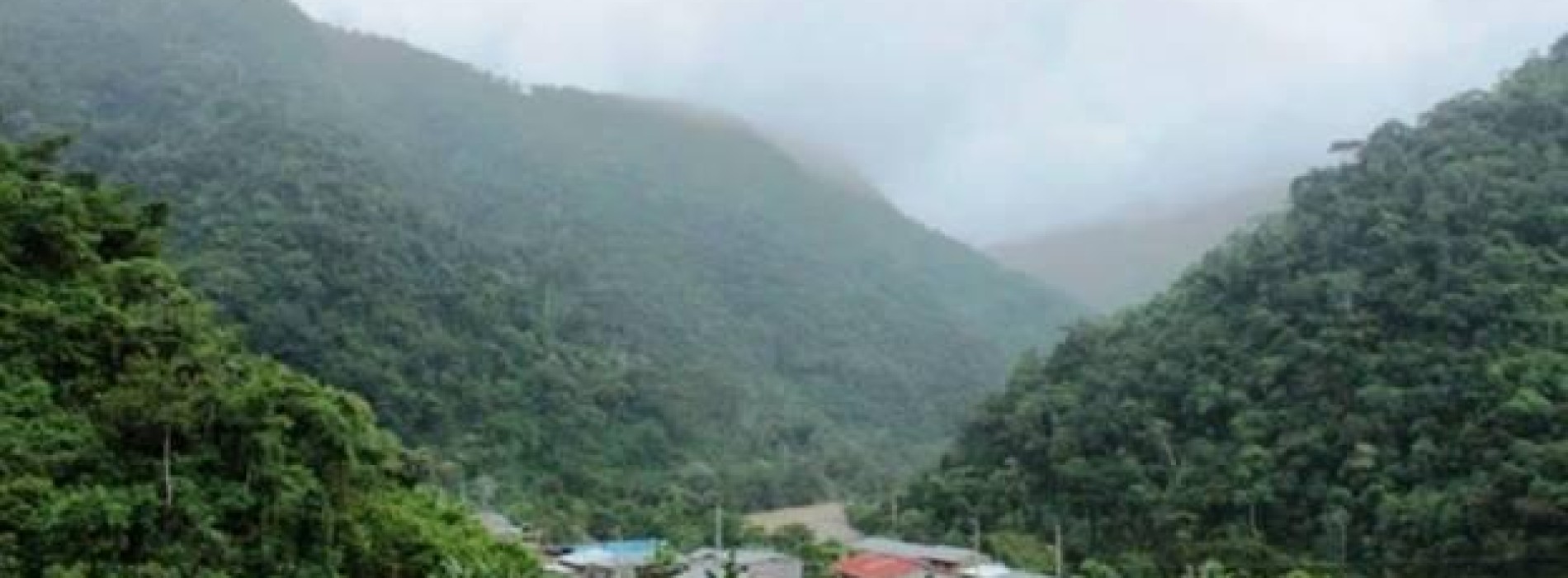
by Deep Green Resistance News Service | Jul 25, 2017 | Reclamation & Expropriation
by Autonomous Territorial Government of the Wampís Nation / via Intercontinental Cry
Translated by Daniel Dayley
After more than half a year from the commitment of the national authorities to execute a third interdiction operation at the illegal mining site established in the Pastacillo stream basin, tributary of the Santiago and Marañón River, in the Amazon region [of Peru], The Autonomous Territorial Government of the Wampís Nation (GTANW), in view of the breach of this commitment, agreed and decided to peacefully evict the illegal miners from that area.
The operation was carried out on July 13, in coordination with the Municipal District of Santiago, and included the participation of approximately 200 members of the wampís communities near the Villa Gonzalo community.
They arrived at the mining establishment in the morning and the workers were peacefully asked to leave the area. At that point the only dredging machine there was confiscated and destroyed. In the afternoon, in Puerto Galilea, a group of people from the community of Yutupis, made up mostly of indigenous Awajun and who are divided because of members who profit from illegal mining, attacked the wampis who had participated in the operation against the illegal mining. A total of four wampís men were wounded in the confrontation.
At the moment, we Wampís are developing collective meetings in order to reach agreements and to take new actions in the future that deal with the onslaught of illegal miners. At the same time, we are demanding the presence of the National Police of Peru in the area to avoid a recurrence of violent episodes on the part of those who work in and benefit from illegal mining.
It should be mentioned that the decision of the action was also communicated in a timely way to the main relevant authorities, such as the PCM (Fernando Zavala), the Ministry of the Interior, the Ministry of Defense, the Ministry of Energy and Mines, the District Attorny’s office specializing in Bagua’s environmental issues, and the PNP of Santa María de Nieva; and requesting of them the necessary support and guarantees.
Through this press release we reiterate our commitment to the defense, protection and preservation of our territories, forests and biodiversity; and we urge the authorities of the Peruvian State to intervene and provide the necessary guarantees for the lives of the indigenous peoples who watch over, protect and fight for humanity’s right to a good life.
Puerto Galilea, July 14, 2017.
Autonomous Territorial Government of the Wampís Nation
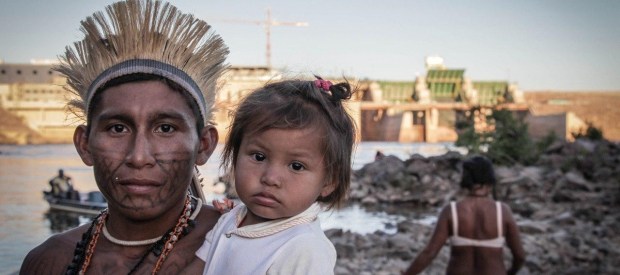
by Deep Green Resistance News Service | Jul 20, 2017 | Obstruction & Occupation
by International Rivers and Amazon Watch / via Intercontinental Cry
At dawn on Sunday, July 16th, 200 representatives of the indigenous Munduruku nation occupied the main work camp of the São Manoel hydroelectric dam on the Teles Pires River in the Brazilian Amazon, paralyzing the project. Led by Munduruku women warriors, the occupiers presented a series of demands to dam developers and Brazilian government authorities, including the right to consultation, land titling, and respect for their cultural and spiritual sites. They also demanded that developers repair the grave environmental destruction inflicted by dams on the Teles Pires.
In an open letter, the Munduruku state: “Our sacred places [such as the Sete Quedas waterfall and burial grounds] were violated and destroyed. Our ancestors are crying… The Teles Pires and Tapajós Rivers are dying. Our rights, guaranteed by the Federal Constitution, which came to exist after much indigenous blood was spilled, are being violated.”
The letter emphasizes that construction of the São Manoel and Teles Pires hydroelectric dams, both located in close proximity to indigenous territories occupied by the Munduruku, Kayabi and Apiaka tribes, constitute a gross violation of the right of indigenous peoples to Free, Prior, and Informed Consent (FPIC), guaranteed by International Labor Organization’s Convention 169, to which Brazil is a signatory. In an effort to support FPIC implementation, in 2014 the Munduruku published a ‘protocol’ in which they laid out guidelines for an appropriate process of prior consultation and consent for proposed projects that would affect their livelihoods and rights. Though they formally presented it to the Brazilian government in 2015, they have yet to receive a reply.
Together with the destruction of the Sete Quedas waterfalls – a site considered to be the center of cosmology for the region’s three indigenous peoples – dams on the Teles Pires River also led to the removal of funerary urns and archeological artefacts on Munduruku burial grounds. Long a major concern of Munduruku leadership, the return of these items is among the principal demands of the occupation.
“I am deeply saddened to be witnessing the destruction of our sacred sites,” said Maria Leusa Kabá Munduruku, one of the principal leaders of the occupation. “We women need to have great strength to cure the pains we are feeling here.”
Now entering its third day, the occupation of the São Manoel dam was conceived by Munduruku women who identified the need to take bold action to stop the ongoing destruction of indigenous rights and territories in the Tapajós River basin.
“After we heard the Munduruku women, it was decided that we would gather peacefully at the São Manoel work camp, motivated by our pain,” says the Munduruku statement. “We are not here to invade. The only invader is the government and the companies responsible for the dams being built on the Teles Pires…. We know that our struggle is legitimate… We ask that our demands be met and will not leave here until they are.”
In response to the indigenous mobilization and work stoppage at São Manoel, members of the dam’s consortium, EESM – composed of the Brazilian affiliate of the China Three Gorges Corporation (CTG); Portugal’s EDP Energias do Brasil; and Furnas, a state-run energy company – filed suit in federal court to end the occupation. The Munduruku countered with a second statement, attesting to their determination to engage in dialogue and to remain on site, resisting efforts to intimidate them. “We only need for our demands to be attended to. Our protest is peaceful and therefore the intervention of the national guard or federal police is not necessary.”
In its only proactive response to Munduruku demands, the government agreed to send the president of the indigenous agency, FUNAI, to visit the occupation site. The Munduruku are skeptical, however, particularly given that FUNAI’s current president, Franklimberg Ribeiro de Freitas, is a highly controversial appointee of Brazil’s right-wing Social Christian Party, which has proved antagonistic to indigenous rights. “It is not enough for him to come here with false promises,” read a Munduruku statement. “We want concrete responses to our needs.”
“Far from the limelight of high-profile, controversial projects like Belo Monte, the São Manoel and Teles Pires dams have involved a series of human rights violations and environmental illegalities since their inception,” said Brent Millikan of International Rivers – Brazil. “The consequences of this steamrolling of the rule of law have included the destruction of sacred sites and devastating downstream impacts on water quality, freshwater ecosystems and fisheries that are essential for the livelihoods of indigenous peoples.”
“The Munduruku occupation demonstrates the extent to which Brazil’s indigenous and traditional peoples must go to make themselves heard,” said Christian Poirier of Amazon Watch. “This a struggle for cultural survival in opposition to a disastrous pattern of environmental destruction and rights violations endemic to Brazil’s Amazon dam-building program.”
The São Manoel and Teles Pires dams are part of a complex of four large hydroelectric projects simultaneously under construction on the Teles Pires River, a major tributary of the Tapajós River in the Brazilian Amazon. The dams were planned by the state-run energy company Eletrobras and the Energy Planning Institute (EPE), both affiliated with the Brazilian Ministry of Mines and Energy. The socio-environmental risks of this dam cascade in the Amazon, including violation of indigenous rights, were systematically underestimated or simply ignored. Environmental licenses and public funding from Brazil’s National Development Bank (BNDES) were approved under intense political pressure.
Investors such as CTG and Iberdrola, a Spanish pension fund, repeatedly ignored warning signs of the projects’ legal, financial and reputational risks. Recently, the CTG-led São Manoel consortium informed indigenous peoples of the Teles Pires River that the closing of floodgates and filling of the dam’s reservoir would begin in August, despite the fact that no such license has been issued by IBAMA, the federal environmental agency. Although dam construction began in 2014, a plan to mitigate and compensate impacts of the São Manoel dam, which should have preceded construction, has yet to receive final approval from FUNAI and indigenous tribes.
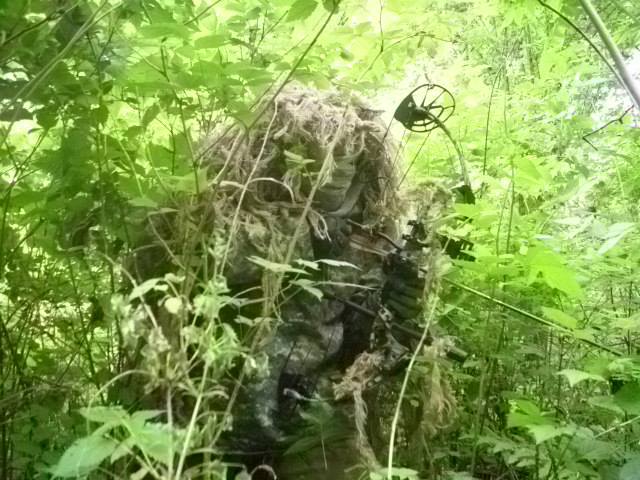
by Deep Green Resistance News Service | Jun 7, 2017 | Direct Action
Editor’s note: This article is adapted from a training held last May 13-14 at the Shxwowhamel First Nation.
by Sakej Ward
Individual Operational Readiness
Do you have an impact on the “battlefield” or are you a liability? Do you possess a wide range of activist’s conflict skills? Are your skills up to speed? Not all activists are created equal.
The come-as-you are activist, the person who shows up at crisis events with intent to engage in obsolete, ineffectual, passive tactics that requires so very little skill and equipment (gear) is an amateur who treats the struggle for justice more as a social gathering (a crisis pow wow with endless opportunities to get selfies) than a war.
On the “Battlefield” good intentions, thoughts and prayers are not enough.
The opposition (the colonial government and its industries of destruction) are deadly serious about counter-activism operations. They see it as a war to protect their vast power and privilege. They see it and treat it like a war. They go to great lengths to plan, prepare, mobilize, equip, deploy and release their dogs of war upon the people.
The gap of capability (including skills and gear) between the activists and the government is immense but it doesn’t have to be. Activists can reduce this capability-gap by training in their particular skill sets and acquiring, modifying and training on the proper highly-specialized gear to get those tasks done in a highly efficient manner.
Skills and gear empower the strategy.
The come-as-you are activist, showing up with little to no skills to conduct critical actions and little to no mission essential gear to pull them off need to take their engagement in “battle” much more serious. They need take more responsibility for their commitment to justice if they want to be of real help.
Your commitment to justice is measured by your willingness to put in the necessary time, effort, resources and sacrifices to make yourself a better weapon of justice.
Activists need to become “Become the Weapon” by becoming Operational Ready in order to be of real help at crisis situations.
Operational Ready consist of two main factors; skills to complete your mission and the gear to fulfill it.
Skills
To be operation-ready for a crisis situation, activists need to determine skills needed to conduct their type of actions. Most activists have no advanced thinking about what kind of assistance he/she will provide or what type of skills their assistance may require.
Developing skills sets starts with creating a training plan. Establishing a training plan begins with an analysis of doctrine, operations (campaigns), missions (actions), tasks and skills.
Activists should start by determining their doctrine (how they fight). The activist’s doctrine may be passive legal, it can be civil disobedience, or the doctrine may be direct.
Next determine the type of operations (campaigns) that are common to those doctrines. It is important to make as complete of a list of common operations (campaigns). These can be operations that are normally conducted by the activist or operations the activist feels his/her doctrine would call for. It would also be wise to realistically anticipate trends towards upcoming new types of conflicts and operations the activists may engage in the near future.
Identifying operations (campaigns) aren’t just about identifying the issue in contention. It’s about identifying the objectives used to successfully complete those operations. For example, an activist participating in Indigenous justice may engage in a Murder and Missing Indigenous Women Campaign (operation). The objective of the operation (campaign) might be to raise awareness of the issue or to bring those responsible to justice. Identifying the objective may generate some ideas on new or unused tactics for specific operations.
After all the operations (campaigns) have been identified the list needs to be broken down further by determining a full range of missions (actions) in those operations (campaigns).
So, an operation (campaign) to save a forest, for activists with a doctrine of civil disobedience, may include missions (actions) like setting up a blockade on a logging road or chaining themselves to a tree while activists with a doctrine of Direct Action may include missions (actions) like taking out a piece of heavy equipment or taking down a bridge on a logging road. The operation is the same but the doctrine creates a different set of mission profiles.
Once a full range of operations and the missions utilized in those operations are identified, then determine the tasks that are necessary to complete those missions (actions). A blockade mission (action) would require tasks like shutting down traffic on a road, barrier construction, interacting with people, interacting with police, interacting with media, guard duty, tactical observation, tactical communications, etc. Some of these skill sets are team skills (stopping a vehicle) and some are individual skills (rolling out barbed wire). Separate the two skills sets (team and individual) involved in those actions. Training plans should be a sequential development of skill sets from individual skills up to team based skills.
In addition to identifying individual skills of these skill sets, determine the standards for those skills. Standards are the level of quality expected for the skill sets. Being able to execute a skill in a poor manner like making several mistakes, taking a very long time to execute it, only can execute the skill with help from references (people, books, videos, etc), can’t do it in the dark or under pressure all ensure failure when it comes time to execute these skills in a crisis situation. Skills need to be practiced to certain level; a standard that reflects the conditions of the actions you will be in. For instance – assigning a standard to applying a first aid pressure dressing should include executing it properly (without mistake), in a designated time, possibly with improvised items, in the dark, in field conditions while under stress. Every skill needs to have a standard assigned to it as a way of establishing the level of training and as a testable condition.
Assemble all the skills and arrange them in blocks of training (like first aid, tactical communications, self defense, etc.). Determine the required sequence of instructing these skills. Some skills require knowing a prior skill first, for example – in order to send a radio message activists would first need to know how to put a specific radio into operation. Assign a timeline to instruct, practice and test each skill. This timeline influences the development of your training schedule.
Finalize the training plan by identifying instructors for each of the skill sets, training areas, training facilities, reference materials, training budgets, and training aids.
Gear
- Identify common gear needed that best fits all the tasks. This is the kind of gear that will be used in most or all crisis situation such as backpack, sleeping bag, sleeping pad, wet weather gear, warm gear, multi-tool, Individual first aid kit, survival kit, etc.
- Identify mission specific gear. This is gear that is specific to the identified missions. It can be barrier construction tools, observation tools, breaching tools, safety equipment, etc.
- Select gear for those actions. Determine the best gear for the task based on a few factors;
Selection Factors
- Cost – We would all love to have the newest, most high tech tactical gear around but cost becomes the barrier to this. Select gear based on a priority list of critical and mission-essential gear first.
- Availability – You may want it but it isn’t available, for whatever reason, to you. Determine good substitutions.
- Quality – much of the gear should be excellent quality because your life or liberty may depend on it. Some gear isn’t as crucial like a rain jacket. Does it need to be the best rain jacket from a high-end store or does it just have to get the job done? There is also good quality used gear for sale, as long as you know what to look out for. Set standards for what you need in your gear before buying.
- Durability – The gear will be used under the worst conditions so don’t expect cheap dollar store gear to hold up under field conditions. Should be simple but rugged.
- Multi-purpose – finding gear that can be used for more than one task increases its value.
- SAWC – Size And Weight Consideration. Sometimes good gear is large, bulky, and heavy and impedes mobility. Look for gear that is as compact, light but still functional for the tasks.
- Camouflage pattern – Bright shiny items attract the eye and can give you away. Determine the best camouflage pattern for the area of operation.
- Waterproof – it will rain in the field so gear needs to be water proof.
- Shockproof – it will be dropped, kicked, sat on, thrown across the room in frustration (or at a threat) but it still needs to function after its abuse.
- Simplicity – the more high tech or the more moving parts invites breakdown. Try to select gear that is simple and robust.
- Best achieves the mission – the main purpose of the gear is to assist in successful completion of missions (actions). That should stay in the forefront of the activist’s mind. When choosing between two possible pieces of gear, determine which best assist in achieving the mission.
- Ergonomic – the gear should be both efficient and comfortable. This extends the time frame for use in work. An uncomfortable or inefficient piece of gear will wear down the activist earlier, making work harder.
The best gear isn’t always the most expensive, coolest looking (tacti-cool), widest advertised or what some other person or group is using. If there are any questions on gear determination or gear selection consult an experienced freedom fighter that is a subject-matter-expert in the use of gear as well as the procurement of gear for specific kinds of operations and missions.
Once a training plan is developed and the gear is obtained the activist needs to train to standard on the skills and with the gear obtained in order to properly fit, modify, personalize and familiarize with that gear.
When all the gear procurement and initial training is complete a series of culmination exercise (based on all the different operations and likely missions for each) should be conducted. It provides an opportunity for testing to standard and evaluating all the common and mission-essential tasks to determine if the activists are operational ready.
“Welcome to my War”
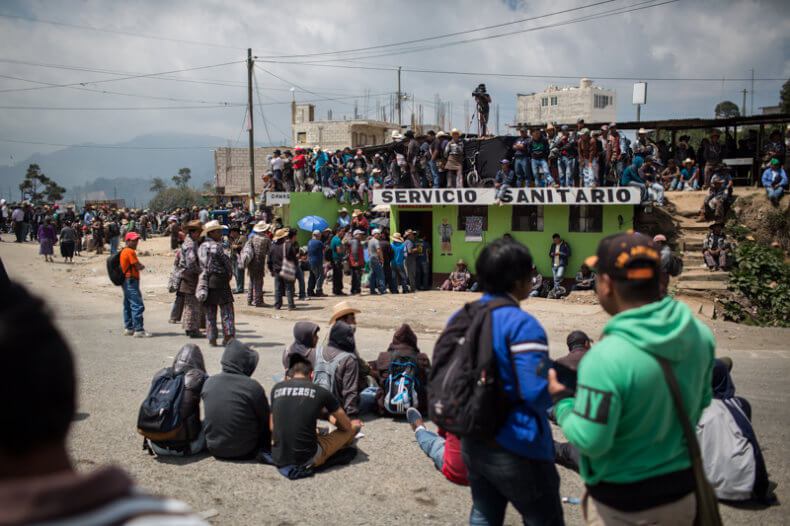
by Deep Green Resistance News Service | Feb 26, 2017 | Indigenous Autonomy, Obstruction & Occupation
Featured image: Protesters gathered at Los Encuentros, by Anna Watts
by Anna Watts / Intercontinental Cry
Indigenous communities across Guatemala have brought the country to a standstill for the second day in a row. Blockading major crossroads and highways, the nationwide peaceful demonstrations are protesting against the Guatemalan congress’s rejection of a constitutional reform that would legally recognize indigenous justice as part of the country’s judicial system.
An estimated 60 percent, or more than 6 million inhabitants, make up Guatemala’s population (IWGIA). Yet indigenous systems of justice, wherein local authorities rule on community issues, have been looked down upon by a country that continues to hugely discriminate against its majority indigenous population. The reforms face opposition from conservatives and major businesses that control most of Guatemala’s land and economy. Although many of these business interests campaigned against the reforms under the guise of fearing “legal confusion,” indigenous activists and leaders at the protests describe the opposition as deriving from a fear of losing any of their elite power to those who have been oppressed and exploited for centuries–Indigenous Peoples.
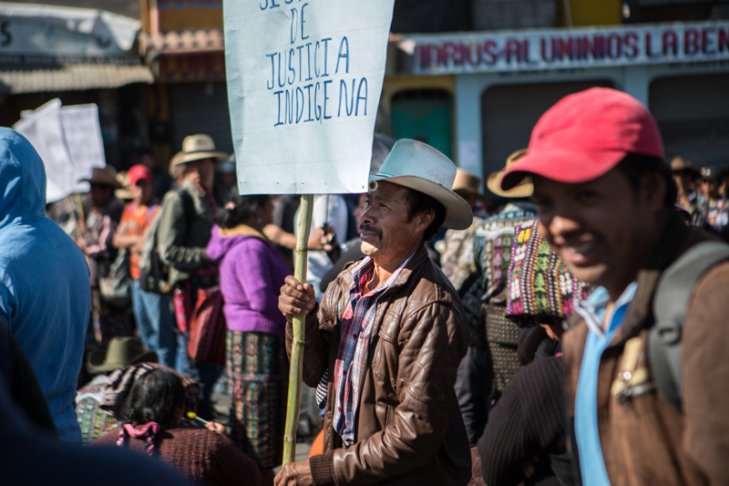
Photo: Anna Watts
At Los Encuentros, one of the most important crossroads between major cities located along the Pan-American Highway, thousands of indigenous people of the Sololá region gathered to participate in the blockades. Carrying handmade signs and led by their respective indigenous leaders, community groups unloaded from packed cargo trucks and chicken buses, carrying ready-made lunches to last through a full day of protesting.
By 8:30 AM, every tienda, comedor, and tortilla stand had been closed down and locked up, a rare sight for the ever-bustling highway hub. The majority indigenous city of Sololá was deserted; not a car in sight nor shop windows open. Pick-up trucks and makeshift blockades of boulders and large tree branches cut off traffic between smaller communities surrounding Lake Atitlán.
Protesters organized and coordinated solely by means of meetings and phone calls between indigenous community leaders. Use of Internet or social media to communicate and gain protest support was entirely avoided out of fear of vulnerability and tracking by police and those opposing the reforms. This distrust was reflected in weak media coverage of the protests; in spite of the thousand plus standing in solidarity at Los Encuentros, only one reporter from a local agency showed up with a small video camera.
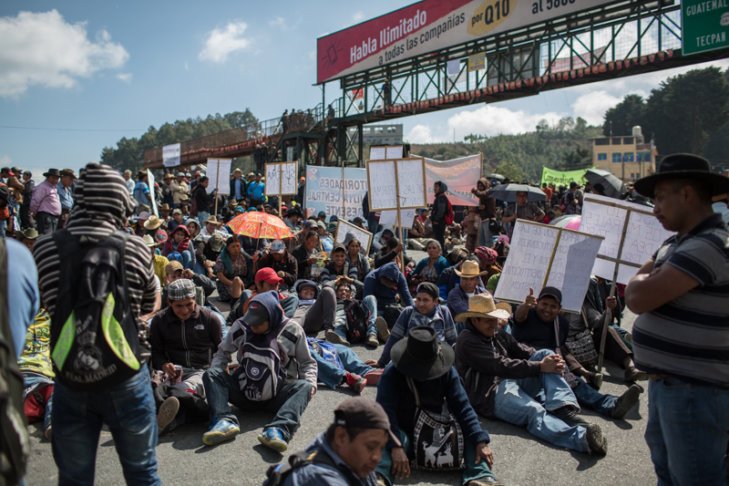
Photo: Anna Watts
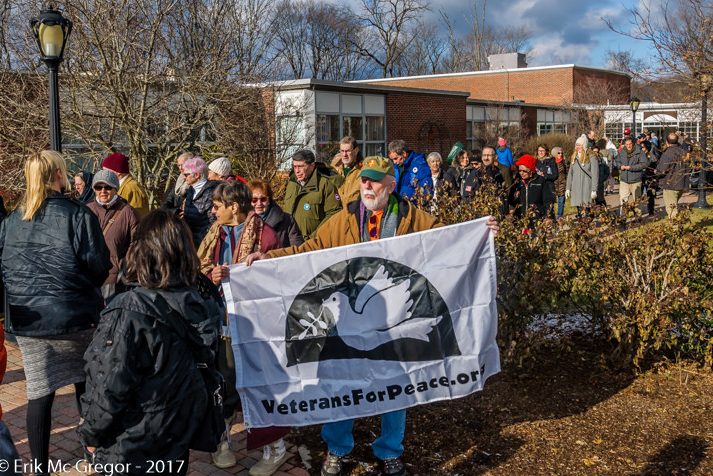
by Deep Green Resistance News Service | Jan 7, 2017 | Obstruction & Occupation
by ResistAim
Cortlandt, NY — On Friday morning – in front of a packed courtroom of over 100 New York residents, activists, sympathizers and supporters opposed to Spectra’s “AIM” Pipeline – Cortlandt Town Court Judge Daniel McCarthy issued sentences for nine New York residents (known as the “Montrose 9”) that were arrested for blocking access to a Spectra Energy construction yard in November 2015. Each of the nine of the defendants were fined and sentenced to community service. The defendants had pled the “Necessity Defense,” arguing that their activity was justified because it was done to stop a danger more harmful than the violation of the law, and only after all other legal and regulatory options had been exhausted. The danger they oppose is Spectra’s “AIM” Pipeline, a high-pressure 42-inch gas pipeline that runs within 105 feet of critical Indian Point Nuclear Power Plant safety facilities. Even though Judge Daniel Murphy ultimately rejected this argument, it is groundbreaking for the necessity defense to be considered, and the community stands with the “Montrose 9.” The defendants’ lawyer, Martin Stolar, has filed an appeal with the appellate division of Westchester’s Supreme Court.
Despite their sentencing, the activists vowed that the fight is not over and that the resistance movement will continue. As “Montrose 9” defendant Linda Snider stated, “It‘s difficult for me to think of myself as ‘guilty’ when I was trying to stop a possible catastrophe. The first part of the Spectra pipeline is now in place and running under the Hudson, right next to a proposed oil barge anchorage site and Indian Point Nuclear Power Plant in Tompkins Cove. What could go wrong? The huge outcry against this and other pipelines lead me to believe that the entire Spectra pipeline will, in the end, never get completed.” Defendant Susan Rutman agreed, stating: “Our communities need champions to protect the citizens, not punish those of us who are taking action and standing up to try to prevent a Fukushima-on-the-Hudson catastrophe. It is with a very sad heart that I stand before you to be sentenced.” Defendant Melissa Friedman stressed, “As an attorney, mother of two and with an ailing partner, I have limited time but I had to do something,” citing a long list of problems related to fracking and climate change. She added, “We’re doomed and it’s time to start acting like it.”
By completing the AIM Pipeline, Spectra Energy has only completed one-third of their overall pipeline expansion project – the “Algonquin” Pipeline Expansion. This is really one pipeline project disguised as three pipelines in order to illegally circumvent Spectra Energy’s obligation to identify cumulative impacts of the project as a whole. So while the AIM battle is over, the Montrose 9 voiced their commitment to winning the overall war in court on Friday.
Defendant Monica Hunken stated to the Judge, “Although we have been found guilty, it will not deter us from continuing to peacefully fight the next two segments of the Spectra pipeline every inch of the way. Whatever punishment we receive is a small price to pay for defending the land, air, water and our precious communities…We are here doing our job, being shepherds of the land. If we do not stand up to corporations, they will mow us down. We cannot allow them to treat us like we are sacrifice zones. I am doing this for you and your family too.”
The “AIM” pipeline has been opposed by local residents, countless local officials, Governor Cuomo, Senator Schumer and Senator Gillibrand, as well as riddled with corruption exposés and conflicts of interest. On February 29, 2016, New York State Governor Andrew Cuomo called for an immediate halt to construction while the state conducts an independent risk assessment; the Federal Energy Regulatory Commission (FERC) denied the Governor’s request. On August 3, 2016, both New York Senators Schumer and Gillibrand wrote to FERC, calling for an immediate halt to construction of the pipeline; FERC also denied the Senators’ request. In November 2016, it was revealed publicly that Phil Suter, the spouse of high-ranking FERC official Maggie Suter – who led the review for two gas pipeline projects by Spectra Energy – is a paid consultant for Spectra on a related pipeline project. Without further regulatory action or support from elected officials, residents and advocates have taken matters into their own hands to directly stop construction. Defendant Mike Bucci questioned the Judge, asking “All of the pieces of government have failed us, and now the judicial system has failed us. Where do we go for protection?”
Although FERC granted Spectra’s request to place the Stony Point to Yorktown portion of the AIM Pipeline into service in 2017, Spectra Energy still needs to complete its Atlantic Bridge and Access Northeast projects for the project to be financially viable. Resist Spectra and its allies across the northeast will oppose Spectra Energy’s reckless plans, rampant greed and toxic proposals at every stage. Factually, these pipelines and their supporting infrastructures are destructive and put tens-of-millions of lives, communities, and the ecosystems on which we depend at risk of imminent danger. As defendant Kathleen Thomas stated in court to Judge McCarthy today, “The response to our plea has to do with the word ‘imminent’. When the real danger is imminent, it will be too late. Once this becomes imminent, we are all gone. There will be no chance to say ‘I told you so’.” By working in solidarity with similar fights across the nation, we will stop Spectra once and for all.
Photos by Erik McGregor
Short video by Peter Eliscu
ResistAim online, on Facebook, and on Twitter
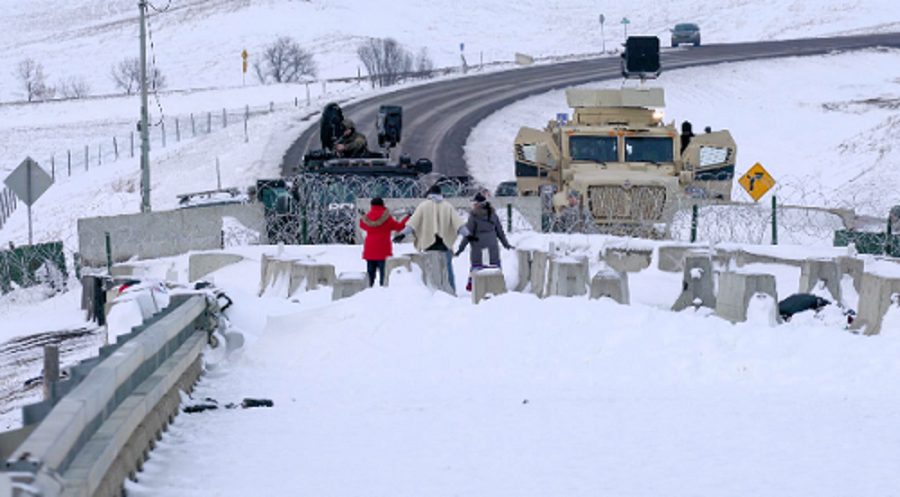
by Deep Green Resistance News Service | Dec 5, 2016 | Obstruction & Occupation
by Indigenous Environmental Network
Cannonball, ND – At approximately 3PM CST a group of about 30 people gathered to create a protective prayer line on the Backwater Bridge, the site of the November 20th attack on peaceful and unarmed water protectors by militarized police. Wesley Clark Jr., an organizer of Veterans Stand with Standing Rock, Kandi Mossett of the Indigenous Environmental Network, and Brenda White Bull who served 20 years in the Marine Corps and is also a direct descendant of Chief Sitting Bull, delivered a message to representatives of the National Guard, the Veterans Association, Tigerswan Private Security, who is hired by DAPL, and North Dakota law enforcement.
Wesley, Kandi, and Brenda walked together across the bridge to have a discussion with representatives on the other side. The purpose of the discussion was to clarify that the delegation of more than 2,000 veterans comes in peace and will remain nonviolent and in prayer during their visit to Standing Rock.
Further discussion was had about resolving tension between Water Protectors and law enforcement and also about the barricade on the bridge, which poses a danger not only to the camps but also the Cannon Ball community as it blocks the fastest route for emergency services. An audio recording of the meeting confirms that North Dakota law enforcement will not be entering the camp.
From December 4th through 7th, 2,000 veterans will descend on Standing Rock to act as a human shield for the water protectors on the front lines of the peaceful protest. The Veterans will also act as protectors of the Oceti Sakowin camp after the Army Corps of Engineers and North Dakota Governor, Jack Dalrymple, have called for its December 5th evacuation.
For Live updates at Standing Rock and the Veterans’ visit, please follow Indigenous Rising Media on Facebook.
Featured image by Spencer Mann, Indigenous Rising Media








